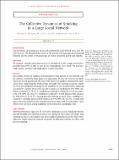| dc.contributor.author | Christakis, Nicholas | |
| dc.contributor.author | Fowler, James H. | |
| dc.date.accessioned | 2010-03-02T15:24:18Z | |
| dc.date.issued | 2008 | |
| dc.identifier.citation | Christakis, Nicholas A., and James H. Fowler. 2008. The collective dynamics of smoking in a large social network. New England Journal of Medicine 358, no. 21: 2249-2258. | en |
| dc.identifier.issn | 0028-4793 | en |
| dc.identifier.uri | http://nrs.harvard.edu/urn-3:HUL.InstRepos:3710308 | |
| dc.description.abstract | Background: The prevalence of smoking has decreased substantially in the United States over the past 30 years. We examined the extent of the person-to-person spread of smoking behavior and the extent to which groups of widely connected people quit together.
Methods: We studied a densely interconnected social network of 12,067 people assessed repeatedly from 1971 to 2003 as part of the Framingham Heart Study. We used network analytic methods and longitudinal statistical models.
Results: Discernible clusters of smokers and nonsmokers were present in the network, and the clusters extended to three degrees of separation. Despite the decrease in smoking in the overall population, the size of the clusters of smokers remained the same across time, suggesting that whole groups of people were quitting in concert. Smokers were also progressively found in the periphery of the social network. Smoking cessation by a spouse decreased a person's chances of smoking by 67% (95% confidence interval [CI], 59 to 73). Smoking cessation by a sibling decreased the chances by 25% (95% CI, 14 to 35). Smoking cessation by a friend decreased the chances by 36% (95% CI, 12 to 55 ). Among persons working in small firms, smoking cessation by a coworker decreased the chances by 34% (95% CI, 5 to 56). Friends with more education influenced one another more than those with less education. These effects were not seen among neighbors in the immediate geographic area.
Conclusions: Network phenomena appear to be relevant to smoking cessation. Smoking behavior spreads through close and distant social ties, groups of interconnected people stop smoking in concert, and smokers are increasingly marginalized socially. These findings have implications for clinical and public health interventions to reduce and prevent smoking. | en |
| dc.description.sponsorship | Sociology | en |
| dc.language.iso | en_US | en |
| dc.publisher | Massachusetts Medical Society | en |
| dc.relation.isversionof | http://dx.doi.org/10.1056/NEJMsa0706154 | en |
| dc.relation.hasversion | http://christakis.med.harvard.edu/pdfs/083_supplement.pdf | en |
| dc.relation.hasversion | http://christakis.med.harvard.edu/pdfs/083.pdf | en |
| dash.license | LAA | |
| dc.title | The Collective Dynamics of Smoking in a Large Social Network | en |
| dc.relation.journal | The New England Journal of Medicine | en |
| dash.depositing.author | Christakis, Nicholas | |
| dc.date.available | 2010-03-02T15:24:18Z | |
| dc.identifier.doi | 10.1056/NEJMsa0706154 | * |
| dash.contributor.affiliated | Christakis, Nicholas A. | |
| dc.identifier.orcid | 0000-0001-5547-1086 | |



